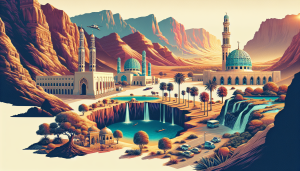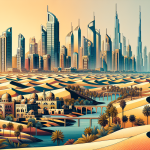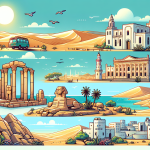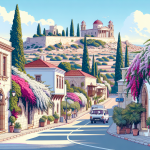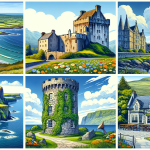Discovering Oman: The Jewel of the Arabian Peninsula
Oman, a country often overshadowed by its more flamboyant neighbors in the Arabian Peninsula, is a hidden gem waiting to be discovered. With its rich history, captivating culture, and stunning natural landscapes, Oman offers a unique travel experience that is both authentic and unspoiled. Whether you’re an adventurous explorer, a history buff, or someone looking to relax in a serene environment, Oman has something to offer. This comprehensive guide will take you through the must-visit destinations, cultural insights, and practical tips to make your journey to Oman unforgettable. We will delve into the vibrant capital city of Muscat, the awe-inspiring deserts, the lush green mountains, and the charming coastal towns. We’ll also explore Oman’s unique customs, delicious cuisine, and the best times to visit. So, pack your bags and get ready to discover the magic of Oman, where tradition meets modernity in the most harmonious way.
The Enchanting Capital: Muscat
Muscat, the capital city of Oman, is a fascinating blend of old and new. The city’s skyline is a mix of traditional Arabian architecture and modern skyscrapers, creating a unique visual contrast. As you wander through the streets of Muscat, you’ll find yourself stepping back in time, yet firmly rooted in the present.
Historical Sites in Muscat
Muscat is home to several historical landmarks that offer a glimpse into Oman’s rich past. The Sultan Qaboos Grand Mosque is one of the largest mosques in the world and a masterpiece of modern Islamic architecture. Its stunning design, intricate mosaics, and the world’s second-largest hand-woven carpet make it a must-visit.
The Royal Opera House is another architectural marvel that combines traditional Omani design with modern technology. It serves as a cultural hub, hosting a variety of performances ranging from classical music to traditional Omani dances.
The Mutrah Souq, one of the oldest markets in Oman, offers a vibrant shopping experience. Here, you can find everything from traditional Omani handicrafts to spices, textiles, and jewelry. The souq’s narrow alleys and bustling atmosphere provide a unique glimpse into Omani culture and commerce.
Modern Attractions in Muscat
While Muscat is deeply rooted in its history, it also embraces modernity. The Oman Avenues Mall and the Muscat Grand Mall offer a contemporary shopping experience with a range of international brands, dining options, and entertainment facilities.
For those interested in marine life, the Oman Aquarium in the Mall of Muscat is the largest in the Middle East. It houses a diverse range of marine species, providing an educational and entertaining experience for visitors of all ages.
The Majestic Mountains: Jebel Akhdar and Jebel Shams
Oman’s mountainous regions offer breathtaking landscapes and thrilling adventures. The Al Hajar Mountains, stretching across the northern part of the country, are home to two of Oman’s most famous peaks: Jebel Akhdar and Jebel Shams.
Jebel Akhdar: The Green Mountain
Jebel Akhdar, known as the Green Mountain, is renowned for its terraced farms, lush greenery, and pleasant climate. The cooler temperatures make it a popular retreat during the hot summer months. Hiking trails in Jebel Akhdar offer stunning views of the terraced fields and traditional Omani villages.
The Diana’s Point, named after Princess Diana, provides a panoramic view of the canyon and surrounding mountains. The nearby Saiq Plateau is famous for its fruit orchards, particularly pomegranates, apricots, and roses. Visiting the plateau during the rose harvest season in April is a sensory delight, as the air is filled with the fragrance of blooming roses.
Jebel Shams: The Mountain of the Sun
Jebel Shams, the highest peak in Oman, is often referred to as the Mountain of the Sun. It offers some of the most spectacular vistas in the country, particularly the Wadi Ghul, known as the Grand Canyon of Arabia. The Balcony Walk along the edge of the canyon is a popular hiking trail that provides awe-inspiring views and a thrilling experience.
For adventure enthusiasts, Jebel Shams offers rock climbing, abseiling, and off-road driving. The cooler climate and rugged terrain make it an ideal destination for outdoor activities.
The Mystical Deserts: Wahiba Sands and Empty Quarter
Oman’s deserts are a testament to the country’s diverse landscapes. The vast expanses of golden sand dunes, the star-studded night skies, and the unique desert wildlife create a mystical ambiance that captivates every traveler.
Wahiba Sands: The Sea of Sand
The Wahiba Sands, also known as the Sharqiya Sands, is a vast desert region characterized by its high dunes and ever-changing sand patterns. A visit to Wahiba Sands offers a quintessential desert experience, with activities such as dune bashing, camel riding, and sandboarding.
The Bedouin communities in Wahiba Sands provide a glimpse into the traditional desert lifestyle. Visitors can stay in desert camps, enjoy traditional Omani cuisine, and experience the warm hospitality of the Bedouins.
The Empty Quarter: Rub’ al Khali
The Empty Quarter, or Rub’ al Khali, is the largest continuous sand desert in the world, extending into Saudi Arabia, Yemen, and the UAE. This remote and inhospitable region offers a sense of solitude and adventure. Exploring the Empty Quarter is a journey into the heart of the desert, with its vast dunes, salt flats, and unique geological formations.
Due to its harsh environment, venturing into the Empty Quarter requires careful planning and often the assistance of experienced guides. However, the reward is an unparalleled sense of isolation and the chance to witness one of the most extreme landscapes on Earth.
The Serene Coastlines: Musandam Peninsula and Salalah
Oman’s coastline, stretching over 3,000 kilometers, offers some of the most beautiful and diverse marine environments in the world. From the rugged cliffs of the Musandam Peninsula to the tropical beaches of Salalah, Oman’s coastal regions are a paradise for nature lovers and water sports enthusiasts.
Musandam Peninsula: The Norway of Arabia
The Musandam Peninsula, located in the northernmost part of Oman, is often referred to as the Norway of Arabia due to its dramatic fjord-like landscapes. The rugged coastline, crystal-clear waters, and towering cliffs create a stunning backdrop for a variety of activities.
Dhow cruises are a popular way to explore the fjords of Musandam. These traditional wooden boats offer a leisurely way to take in the breathtaking scenery, with opportunities for snorkeling, diving, and dolphin watching.
The town of Khasab, the capital of the Musandam Governorate, is known for its historic fort and vibrant fish market. The surrounding area offers excellent opportunities for hiking and off-road driving, with trails that lead to secluded beaches and mountain viewpoints.
Salalah: The Tropical Paradise
Salalah, located in the southern Dhofar region, offers a stark contrast to the arid landscapes of northern Oman. Known for its monsoon season, or Khareef, Salalah transforms into a lush green paradise during the summer months. The region’s coconut plantations, banana groves, and pristine beaches create a tropical ambiance that is unique in the Arabian Peninsula.
The Al Mughsail Beach, with its white sands and blowholes, is a popular destination for both relaxation and adventure. The nearby Wadi Darbat offers scenic waterfalls, lakes, and hiking trails that are particularly enchanting during the Khareef season.
Salalah is also a cultural hub, with historical sites such as the Al Baleed Archaeological Park and the Taqah Castle. The city’s rich heritage is celebrated during the Salalah Tourism Festival, which showcases traditional Omani music, dance, and crafts.
Cultural Insights: Traditions and Cuisine
Oman is a country deeply rooted in its traditions and cultural heritage. Understanding and appreciating Omani customs and cuisine is an integral part of the travel experience.
Traditional Omani Customs
Omanis are known for their hospitality and warmth. When visiting an Omani home, it is customary to remove your shoes and greet the host with a warm “Marhaba” or “As-salamu alaykum.” Offering dates and coffee, known as Kahwa, is a traditional gesture of hospitality.
Omani men often wear a Dishdasha, a long white robe, while women wear an Abaya and a headscarf. The traditional Omani dagger, or Khanjar, is a symbol of national pride and is often worn during special occasions.
Omani Cuisine
Omani cuisine is a delightful blend of Arabian, Persian, Indian, and African influences. The use of spices such as saffron, turmeric, and cardamom adds a unique flavor to Omani dishes.
Shuwa, a traditional Omani dish, consists of marinated lamb slow-cooked in an underground sand oven. Majboos, a rice dish with meat or fish, is flavored with a blend of spices and often garnished with nuts and raisins. Mashuai, a dish of grilled kingfish served with rice, is another popular Omani delicacy.
Traditional Omani sweets, such as Halwa and Dates, are often enjoyed with Kahwa. Halwa, a gelatinous sweet made from sugar, rosewater, and various nuts, is a staple at Omani celebrations.
Practical Tips for Traveling in Oman
Traveling to Oman requires some preparation and understanding of local customs and regulations. Here are some practical tips to ensure a smooth and enjoyable trip.
Best Time to Visit
The best time to visit Oman is during the cooler months from October to April. The temperatures are more pleasant, making it ideal for outdoor activities and sightseeing. The Khareef season in Salalah, from June to September, is also a unique time to visit, as the region transforms into a green oasis.
Visa and Entry Requirements
Most travelers to Oman require a visa, which can be obtained online or upon arrival at designated entry points. It is advisable to check the latest visa regulations and requirements before traveling.
Health and Safety
Oman is a safe country with a low crime rate. However, it is always wise to take standard precautions, such as safeguarding your belongings and avoiding isolated areas at night.
Drinking tap water is generally safe in major cities, but it is recommended to use bottled water in remote areas. It is also advisable to have travel insurance that covers medical expenses.
Local Etiquette
Respecting local customs and traditions is essential when traveling in Oman. Dress modestly, particularly in rural areas and religious sites. Public displays of affection are frowned upon, and it is important to seek permission before taking photographs of people.
Transportation
Oman’s road network is well-developed, making it easy to explore the country by car. Renting a car is a convenient option, particularly for visiting remote areas. Taxis are also widely available in cities, and ride-hailing apps such as Mwasalat and Otaxi offer reliable services.
Conclusion: Embrace the Omani Experience
Oman is a destination that offers a rich tapestry of experiences, from its vibrant cities and majestic mountains to its mystical deserts and serene coastlines. The country’s warm hospitality, unique culture, and diverse landscapes create a travel experience that is both enriching and unforgettable.
By exploring the historical sites of Muscat, the natural wonders of Jebel Akhdar and Jebel Shams, the mystical deserts of Wahiba Sands and the Empty Quarter, and the serene coastlines of the Musandam Peninsula and Salalah, you will discover the true essence of Oman. Embrace the Omani traditions, savor the delicious cuisine, and take the time to connect with the local people.
Whether you’re an adventure seeker, a history enthusiast, or someone looking to unwind in a tranquil setting, Oman has something to offer. So, embark on your journey and let the beauty and charm of Oman captivate your heart.
For more travel inspiration and practical tips, visit Lonely Planet.
